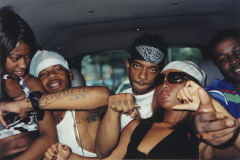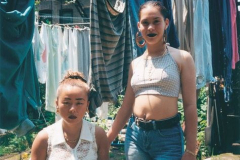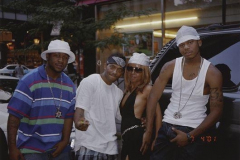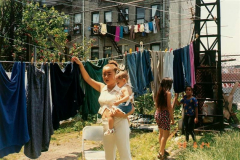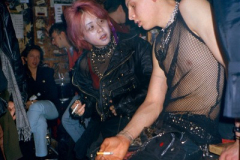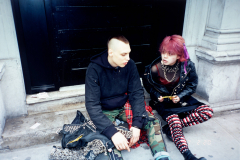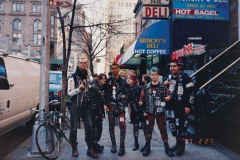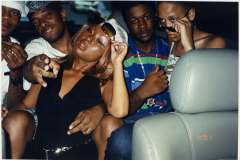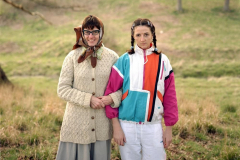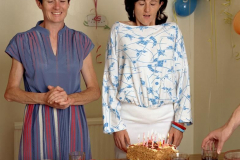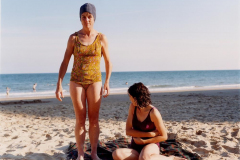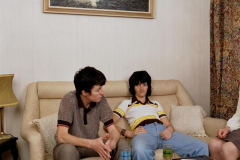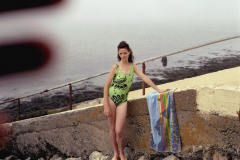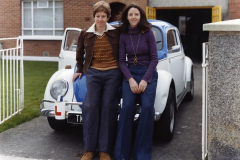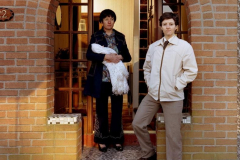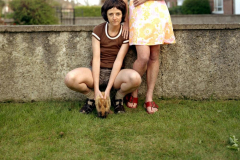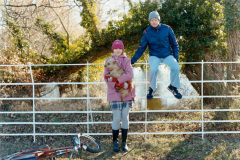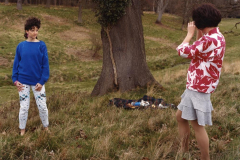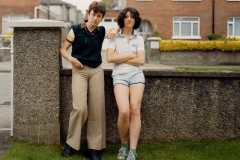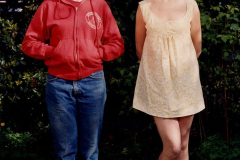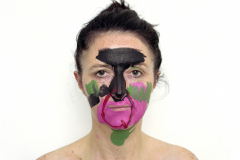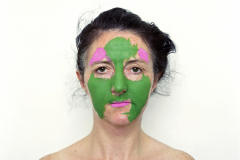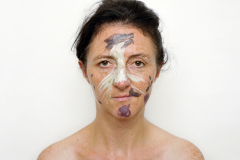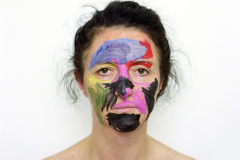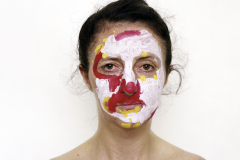Exercise 2: Self-Representation
1.Is there any sense in which Lee’s work could be considered voyeuristic or even exploitative? Is she commenting on her own identity, the group identity of the people she photographs, or both?
2. Would you agree to Morrissey’s request if you were enjoying a day on the beach with your family? If not, why not?
3. Morrissey uses self-portraiture in more of her work, namely Seven and The Failed Realist. Look at these projects online and make some notes in your learning log.
Nikki S. Lee
Nikki Seung-hee Lee is a visual artist born in Geochang, South Korea. Currently working in New York City, Lee works professionally in the field of photography and film. Wikipedia
‘The artist Nikki S. Lee seemed to be everywhere—and everyone—in the late ’90s and early 2000s. She is best known for her “Projects” series (1997–2001), in which she attempted to assimilate into various social and subcultural groups—among them young punks, senior citizens, yuppies, and hip-hop fans—by precisely mimicking their styles and mannerisms. She would appear with them in casual group snapshots taken by friends or passersby, the amateur point-and-shoot images reinforcing Lee’s attempt at verisimilitude. The series, which she began working on as an MFA student at New York University, quickly caught the art world’s attention. She had her first solo show, at Leslie Tonkonow, in 1999, a year after graduating. By the end of the 2000s Lee had left New York for her native Seoul, where she lives today.’ (https://www.artnews.com/art-in-america/features/nikki-s-lees-shapeshifting-art-cultural-appropriation-1202682096/ accessed 07/03/2022)
Lee’s work is about identity and group dynamics. As she explained in an interview (2006) with curator RoseLee Goldberg, “Western culture is very much about the individual, while Eastern culture is more about identity in the context of society. You simply cannot think of yourself out of context.” Her work is almost a form of performance art where she studies the groups in question for months then acts out a series of photos. Her work has resonated in step with identity politics, in the 90s it was topical to talk about multi-culturism while more recently cultural appropriation and its focus on inappropriate use or adoption of elements other cultures. Lee’s work has had it critics and in the Hispanic and the Hip Hop Projects, where she darkened her skin and dresses up in what Wendy Vogel describes as ‘ethnic drag’, she drew parallels of using ‘black face’ However, her work has not only driven debate but has firmly put group and identity dynamics under the spotlight including the malleability of identity and limits of assimilation.
To accuse Lee of being voyeuristic or exploitative or Eunsong Kim criticisms that her subjects are anonymous and akin to colonial travel photography, highlights the complexities of identity politics and the emotions it drives. For sure some of Lees images highlight incongruities where her presence doesn’t feel 100% authentic but I wouldn’t see that as exploitative or voyeuristic.
Trish Morrissey
My work is a study of the language of photography through still and moving images. I use performance and wit as tools to investigate the boundaries of photographic meaning. Although most of my work features myself as the protagonist, I don’t consider them to be self portraits per se, though they can be read that way. I use humour as a tool to disarm the viewer, which I hope evaporates leaving a slow burning psychologically tense afterglow. Weaving fact and fiction, I plunge into the heart of such issues as family experiences and national identities, feminine and masculine roles, and relationships between strangers.
Born in Dublin, I now live in the UK. My work is exhibited widely, most recently at Bohusläns Museum, Sweden, 2017, Serlachius Fine Art Foundation, Finland and Turner Contemporary, Margate, UK, both in 2015 and at Palazzo Strozzi, Florence, Italy in 2014. I was a finalist in the Video section of Celeste Prize in 2012. My work is in the permanent collection of The Museum of Fine Art, Houston, Victoria and Albert Museum, London, The National Media Museum, Bradford and the Wilson Centre for Photography, London. My work is included in several survey publications, including ‘The Photograph as Contemporary Art’ by Charlotte Cotton, (Thames and Hudson, 2005) ‘Vitamin Ph, Survey of International Contemporary Photography,’ (Phaidon 2006), ‘Auto Focus: The Self-Portrait in Contemporary Photography’, by Susan Bright (Thames and Hudson 2010), and Photography and Ireland by Justin Carville, published by Exposures 2012.(https://www.lensculture.com/trish-morrissey accessed 13/03/2022)
Would you agree to Morrissey’s request if you were enjoying a day on the beach with your family? If not, why not?
My first reaction would be not agree to Morrissey’s request-maybe if she explained who she was and gave a good context, then perhaps I might. I would find the request socially awkward and a bit ‘left-field’. I would also be thinking of my family (though they would have their own views) and our privacy, where would the photos be used, can I trust they wont be used for nefarious purposes etc. I think a lot of ‘what if’s’ would kick in and challenge me and I would need convincing.Obviously Morrissey is good at that as she good a lot of families to do and the results are more natural than I would have expected.
Seven
Nostalgic, vintage-style snapshots in which the photographer (and sometimes her sister) sit in for each and every family member. With so much photography now shared digitally, the family photo album is quickly becoming a historical oddity.(https://www.lensculture.com/trish-morrissey 13/03/2022)
This series struck a chord with me, especially her comment ‘In the past, looking through albums required a ritualized oral dialogue of storytelling, descriptions, memory-making, nostalgia and celebration—as well as denial, absences and secrecy.’( https://www.lensculture.com/articles/trish-morrissey-seven-years accessed 13/03/2022) Her series touches upon the nature of images-a sliver of time captured but without the context of what came before or after. Some families are happy, some not, but many like to portray an ‘ideal’ in the family snap. Although the traditional family snap has been replaced by the immediacy of the digital/social media record it still holds (for me) a very important place in the history of photography. It may have had a ritualistic aspect as we all put on our best camera face but it told a family history to be handed down with or without context.
Morrissy’s inclusion of herself and her sister in the series to recreate the images can also be seen as part of that nostalgic drive thats in most of us. Photographs bond us and remind us of who we are.
The failed Realist
The Failed Realist images are based on the theories of French Psychologist Georges-Henri Luquet.
Georges-Henri Luquet was a French philosophy professor born in 1876 and died in 1965 who wanted to study the evolution of children’s drawing starting from what else was at hand; the drawings of his daughter Simmone. His works include The Drawings of a Child ( 1913 ) and The Children’s Drawing ( 1927 ).
The four stages that the child goes through in his drawings are, according to Luquet:
• Chance realism (two to two and a half years).
• Frustrated/Failed realism (two and a half to four years).
• Intellectual realism (four to seven or eight years).
• Visual realism (from eight onwards).
(https://second.wiki/wiki/georges-henri_luquet accessed 20/03/2022)
According to Morrissey ‘Between the ages of 4 to 6 children are often more verbally articulate than they are visually, and what they wish to express through mark making is often beyond their physical skill. The psychologist Georges-Henri Luquet (1927/2001) called this The Failed Realist stage – the child’s desire to represent his or her world is hampered by motor, cognitive and graphic obstacles that will be overcome with time, but for the moment, their interpretation is flawed. These drawings are uncorrupted by representational conventions. The Romantic artists thought this was a reflection of direct access to the expressive self and strove for a return to this innocence in their own painting. Later on, painters of the modernist movement, such as Picasso, Miro, and Klee saw the drawings of children with their mixed perspectives and exaggerated features as a pure and unencumbered way of seeing.
This photographic series was made in collaboration with my daughter between January and October 2011 when she was four and a half to five and a half years old. Face painting is a rainy day activity that we both enjoy. Once her motor skills evolved sufficiently well for her to control a paintbrush, she wanted to paint me rather than be painted. Instead of the usual motifs of butterfly, or flower, she would decide to paint something from her immediate experience – a movie she had just watched, a social event, a right of passage, or a vivid dream. Beyond the innocence of the child’s intention, more sinister themes such as clowns, carnival and the grotesque are evoked by these mask-like paintings.’
This series brings together both an adult and child view of the world. Morrissey interprets them as ‘sinister’ while the paintings at first glance (I didn’t read the artist’s description until afterwards) appear child-like until our adult experience of the world takes over opening many avenues of interpretation.
References
https://www.artnews.com/art-in-america/features/nikki-s-lees-shapeshifting-art-cultural-appropriation-1202682096/
https://www.lensculture.com/articles/trish-morrissey-seven-years
https://second.wiki/wiki/georges-henri_luquet
https://www.lensculture.com/projects/228833-the-failed-realist#:~:text=their%20physical%20skill.-,The%20psychologist%20Georges%2DHenri%20Luquet%20(1927%2F2001)%20called,moment%2C%20their%20interpretation%20is%20flawed.


